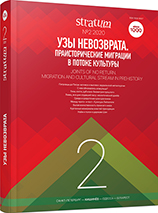Посткатакомбная эпоха Восточной Европы: миграции или военные походы
Post-Catacomb Period of Eastern Europe: Migration or Military Campaigns
Author(s): Roman A. LytvynenkoSubject(s): History, Archaeology, Military history, Migration Studies
Published by: Издательский дом Stratum, Университет «Высшая антропологическая школа»
Keywords: South of Eastern Europe; latest phase of the Middle Bronze Age; Babino Cultural Circle; migration; remigration; warfare; paleodemography;paleoclimate;
Summary/Abstract: The Post-Catacomb period in the south of Eastern Europe left archaeological data that can be regarded as evidence of the mass movements of pastoral peoples. Such evidence is most clearly manifested in the Dnieper-Don Babino Culture (DDBС), which is part of the Babino Cultural Circle, which covered the steppe — forest-steppe zone between the Volga and the Prut during 2200—1800 BC cal. The burial mounds of the DDBC are characterized by a reliable five-stage periodization and, using the mapping method, reveal a clear territorial-chronological dynamic of the culture itself. The DDBC area at its early stage (ІА) covered the territory between the Dnieper, Seversky Donets and the Azov Sea. During the next stage (IB), a significant expansion of the distribution area of the DDBC monuments in all directions, especially latitudinal, is recorded: in the east they reach the Volga river, and in the west — almost the lower Dniester. In the next phase (ІІА) in the west, the monuments of the DDBC return to their original borders. At the same time, in the east, a certain expansion of the DDBC area within the Don-Volga interfluves is recorded. And only from the next stage (ІІБ) does the reverse reduction of the eastern DDBC lands begin. At a late stage (ІІІ), the DDBC area is reduced almost to its initial state.The analysis of sex-age data showed that the annexed territories are characterized by atypical paleodemographic indicators: burials of young and mature men are prevailed or exceptional here; in contrast, women and children either are not found at all or are single; the masculinization coefficient in various areas is in the range of 4,5—22. The expansion of the DDBC area in the east and west, as well as the reverse narrowing in the east, have expressive military signs: some male burials are equipped with weapons and sets of tools for arrow-making, have signs of mortal wounds, there are reburials of “packages” of bones.Despite the general similarities, the movement to the east and west have differences in demographic indicators, features of presence in new territories and duration in time. The phased expansion of the DDBC area to the east, to the Volga, seems to be a militant migration, accompanied by crowding out neighbors and development of new territories. Vice versa, the rapid advance to the west, to the Lower Dniester is more like a short-term military campaign which became the reason or catalyst for the transformation of the Ingul Catacomb Culture into the Dnieper-Prut Babino Culture (DPBC).
Journal: Stratum plus. Археология и культурная антропология
- Issue Year: 2020
- Issue No: 2
- Page Range: 333-357
- Page Count: 25
- Language: Russian
- Content File-PDF

